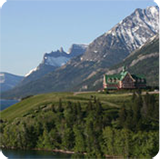Affiliated National Park Units

Glacier National Park
Straddling the Continental Divide in northwestern Montana, Glacier encompasses more than a million acres of incomparable mountain scenery. Its sculptured peaks and crystalline lakes are remnants of extensive ice age glaciation. The mix of geological features and the area's convergence of several ecosystem types has given rise to a diversity of habitats, providing homes to a wide variety of plants and animals. The park’s story also includes thousands of years of human interaction with the land.

Grant-Kohrs Ranch
National Historic Site
Wide open spaces, the hard-working cowboy, his spirited cow pony, and vast herds of cattle are among the strongest symbols of the American West. Once the headquarters of a 10 million-acre cattle empire, Grant-Kohrs Ranch is now a working cattle ranch that preserves these symbols and commemorates the role of cattlemen in American history.

Little Bighorn Battlefield
National Monument
In 1876, 263 soldiers and attached personnel of the U.S. Army, including Lt. Col. George A. Custer, died at the hands of several thousand Lakota and Cheyenne warriors. This was one of the last armed efforts of the Northern Plains Indians in their struggle to preserve their way of life.

Waterton Lakes National Park
Rugged, windswept mountains rise abruptly out of gentle prairie grassland in spectacular Waterton Lakes National Park in Alberta, Canada. Here, several different ecological regions meet and interact in a landscape shaped by wind, fire, flooding, and abundant plants and wildlife. The park helps to protect the unique and unusually diverse physical, biological and cultural resources found here. Together with Glacier National Park, Waterton-Glacier is a World Heritage Site and the world's first International Peace Park.
Last updated: August 4, 2023
